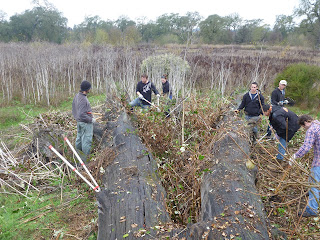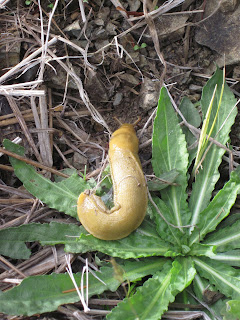On November 16, 2012 students of the Restoration Ecology class gathered at Balletto Winery, eager to learn about the Laguna de Santa Rosa and even flex their muscle to help restore portions which have been invaded by non-native species such as Himalayan Blackberry
As the day began and the students energized, running off of coffee and enthusiasm (except for Nick mid yawn) and received a breakdown of the days events from Brent Reed, Restoration supervisor of the Laguna de Santa Rosa Foundation
The first stop was at Kelly farm to observe three man made waste water pools designed in the early 90's to naturally diffuse water and abstract unwanted nutrients and bacteria using bull rushes, cattails, willows, and cottonwoods. The waste water is diverted from the city of Santa Rosa and used to irrigate large fields for hay production for neighboring farms throughout the county of Sonoma

Next stop was the Duer creek restoration site just south of the Kelly farm ponds, an active site overseen by the Laguna de Santa Rosa Foundation attempting to widen the riparian corridor to provide habitat for native birds and other animals in the Laguna as well as help suppress the extreme invasion of Harding grass, Prickly lettuce, Teasel, and Curly Dock. Seen in the picture above are Coyote Bush (Bacchris pilularus), Oregon Ash (Fraxinus latifolia), Valley Oak (Quercus lobata), rose (Rosa californica), Elderberry (Sambucus mexicana), and Box Elder (Acer negundo). The strips of dead brown foliage between plants is a result of the Foundation's attempt at suppressing weeds to allow the native plants to grow using a chemical mixture of Chateau, Rodeo, and Li-700 sprayed using backpack sprayers.
After a wonderful bathroom break at the Chevron the students were eager to enter the Meadowlark restoration site, the largest active site overseen by the Foundation
Students were able to observe the growth and success of plants from 2006-2012 and the vast irrigation systems installed to help establish these native species. Here the explanation of how funding such a vast project was explained as various funding sources such as the Sonoma County Open Space District, Cal Trans, and the City of Sebastopol.
FINALLY! It was time to get down and dirty with some Himalayan Blackberry. Students jumped at the opportunity to grab a pick-axe, shovel, or McCloud and rip away at the invasive species seen here growing over fallen oak tree trunks. It was a fulfilling and satisfying feeling to do their part and help restore the Laguna de Santa Rosa with their own hard work and dedication!
Do you feel luck...punk...do ya?
Todd.....aka The Restoration Man. With his camo beanie, tooth necklace, and shears he can destroy any invasive species in his path...in mere seconds..
and his helpful side kick....Shovel Boy!!!
and Shovel Boy's dependable side kick....Captian Matty!
At the end of the day the students of Sonoma State's 2012 Restoration Ecology class were tired, cold, wet, and dirty. But they never felt better. The blackberry was knocked back and they even helped save a California Buckeye tree from being engulfed by the fast growing canes of the Blackberry. They all slept a little bit better that night knowing the service they did in helping the Laguna de Santa Rosa Foundation help restore their largest site known to date. The Blackberry was down...but certainly not out. In just a few months the evil exotic species will surely return and wait for the right time to invade again. Until next time, when the students of Caroline Christian's class come back to serve their duty and restore the Laguna once more.























































